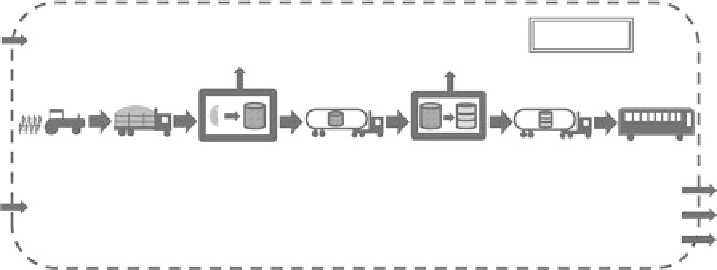Environmental Engineering Reference
In-Depth Information
System boundary
Energy
resources
examples:
Crude oil
Natural gas
Electricity
Coal
Soybean biodiesel
life-cycle model
Co-products:
Soybean meal
Co-products:
Unrefined glycerol
Production:
Soybean
cultivation and
harvest
Transport:
Soybeans to
crushing
Crushing:
Soybeans to
crude soybean oil
Transport:
Crude soybean
oil to refinery
Refining:
Crude soybean oil
to biodiesel
Transport:
Biodiesel to
distribution
Urban bus
operation:
Biodiesel
GHGs/air
emissions
Water
emissions
Solid waste
Material
resources
examples:
Fertilizer
Seed
Water
FIGure 11.8
Soybean biodiesel life-cycle model. (From Sheehan, J., et al., Life cycle inventory of biodiesel
and petroleum diesel for use in an urban bus. NREL/SR-580-24089, National Renewable Energy Laboratory,
Golden, CO, 1998.)
equipment for farming were not included within the system boundaries. Crop yield data came from
the 14 major soybean-producing states in the United States, which accounted for 86% of national
soybean production at the time of the study. Phosphate and potash (potassium) were the most heav-
ily used fertilizers, with lesser amounts of nitrogen also applied. Soybeans, unlike corn, are able to
capture and fix nitrogen from the atmosphere. Herbicide and insecticide (agrochemicals) application
were also factored into the model. The Sheehan et al. (1998) biodiesel life-cycle model is shown in
Fig u re 11.8.
For the agriculture phase, diesel tractor use was attributed with 37% of the primary energy, followed
by agrochemical production (19%), nitrogen fertilizer production (10%), gasoline tractor and gasoline
truck use (10% each), phosphate fertilizer production (7%), and potash fertilizer production (4%). On
average, soybeans were transported 75 miles from the fields to crushing mills, and the primary energy
associated with this phase was only 5% of what was required for agricultural production.
Modeling of soybean crushing was based on past detailed studies, updated with recent data for
key components such as the thermal efficiency of soybean dryers. The crushing process consists of
five steps: (1) whole soybeans were stripped of their hull and ground into smaller flakes; (2) solvent
was applied to chemically extract the oils; (3) the remaining bean, which no longer contained oil,
was ground into a marketable meal product; (4) the mixture of solvent (hexane) and soybean oil
(triglycerides) was separated for solvent reuse and further purification of the soybean oil; and (5) the
soy oil was washed with water to remove unwanted gums (phosphatides).
The relative magnitudes of the electricity, natural gas, and steam requirements of the soybean
crushing subprocesses are shown in Figure 11.9. Soybean drying, during receiving and storage, used
natural gas-powered equipment and was one of the most energy-intensive steps at the crushing facil-
ity. The final crude soy oil product contained 92.5% of the oil originally contained in the delivered
beans. The soybean crushing facility produces 18% soy oil and 82% meal, by mass. The crude soy
oil is then sent to a refinery, where glycerine and methanol are recaptured for sale and reuse, respec-
tively. The refinery produces 18% unrefined glycerol and 82% biodiesel, by mass. Detailed analysis
of this production phase can help identify key opportunities for improvement.
11.2.2.2.3
Urban Bus Operation
The ethanol life-cycle studies discussed earlier were generally normalized on a fuel energy
content basis to facilitate comparison with gasoline. Although a gallon of biodiesel contains
approximately 10% less energy than a gallon of diesel, supporting data examined by Sheehan
et al. (1998) found that biodiesel fuel economy varies only slightly in comparison to petroleum
diesel. In this study, it was assumed that the biodiesel and conventional diesel buses operated at
the same fuel economy.

